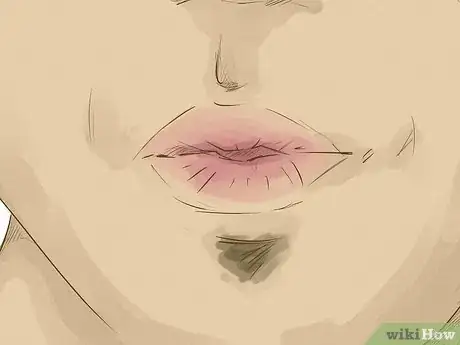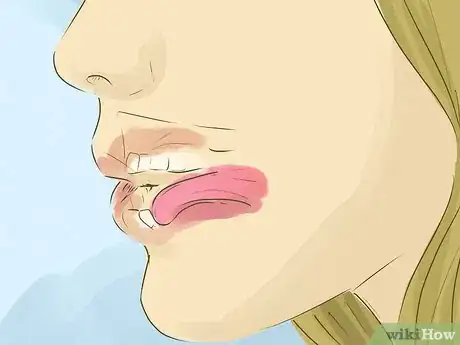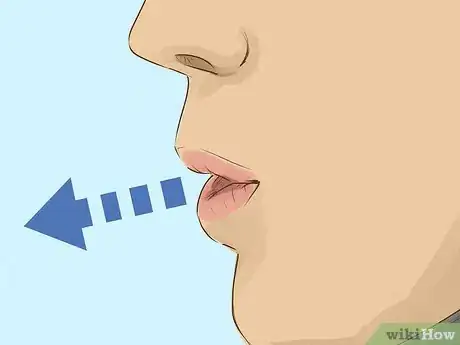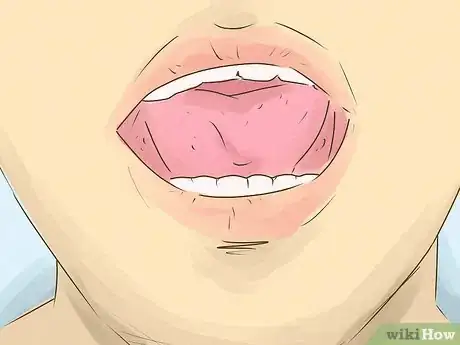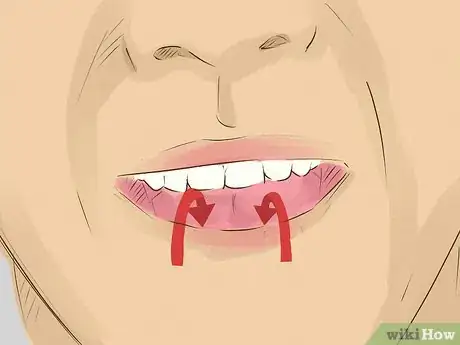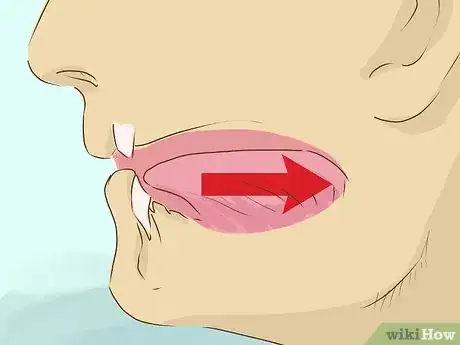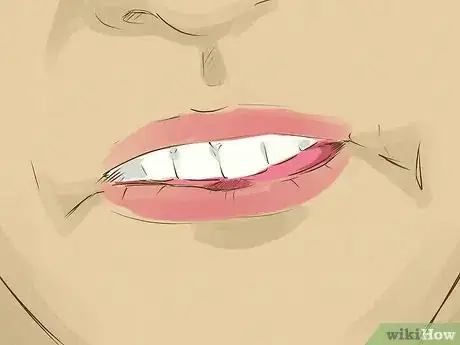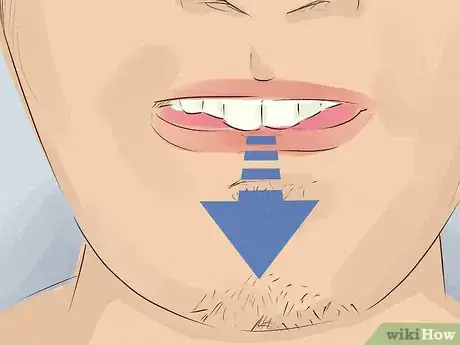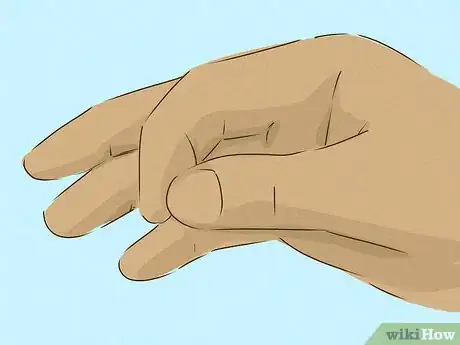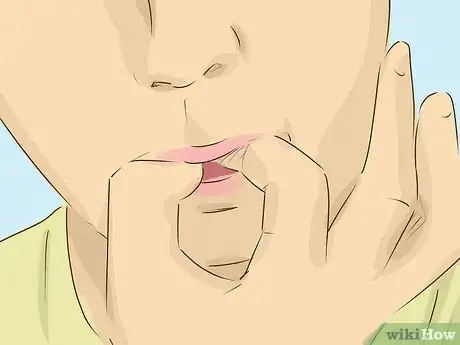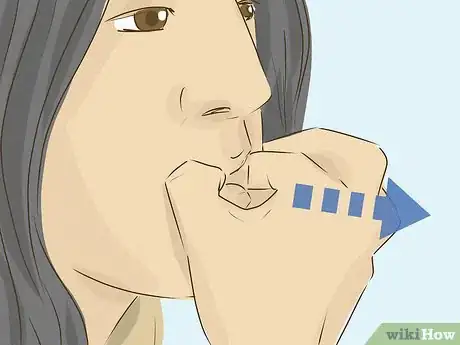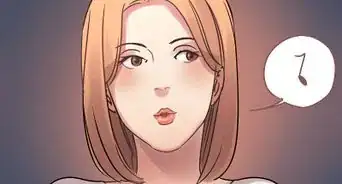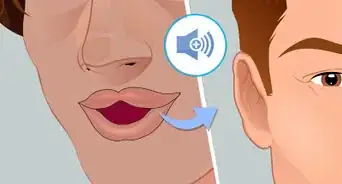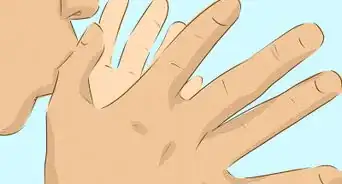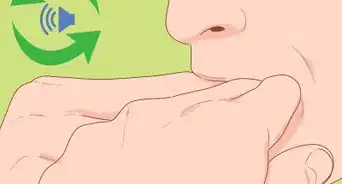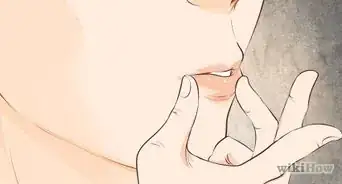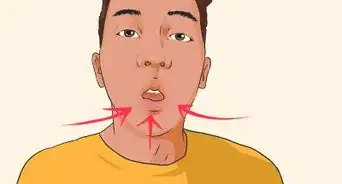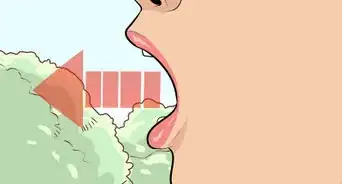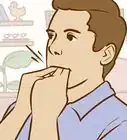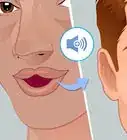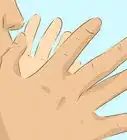wikiHow is a “wiki,” similar to Wikipedia, which means that many of our articles are co-written by multiple authors. To create this article, 143 people, some anonymous, worked to edit and improve it over time.
There are 8 references cited in this article, which can be found at the bottom of the page.
This article has been viewed 2,630,914 times.
Learn more...
Whistling can be as simple as 1-2-3, but it can take a few tries before you produce a sound. With the right technique and a little practice, though, you’ll be whistling in no time.
Steps
Whistling With Your Lips
-
1Pucker your lips. Pretend like you're about to give a kiss, and make your lips into a puckered shape. The opening in your lips should be small and circular.[1] Your breath flowing through this opening will produce a range of musical notes.
- Another way to get your lips in the right position is to say the word "two."
- Your lips should not be resting against your teeth. Instead, they should be stretched slightly forward.
- If your lips are quite dry, lick them before you begin whistling. This may help improve the sound you produce.
-
2Curl your tongue slightly. Curl the edges of your tongue slightly upward. As you begin whistling, you'll change the shape of your tongue to produce different notes.[2]
- For beginners, rest your tongue against your bottom row of teeth. Eventually, you should learn to move the shape of your tongue to form different tones.
Advertisement -
3Begin blowing air over your tongue and through your lips. Blow gently, slightly altering the shape of your lips and the curve of your tongue until you're able to produce a clear note. This may take a few minutes of practice, so don't give up too quickly. It might take a while.[3]
- Don't blow hard, just softly at first. You'll be able to whistle more loudly once you find the right form for your lips and tongue to take.
- Wet your lips again if they dry out while you're practicing.
- Pay attention to the shape of your mouth when you find a note. In what exact position are your lips and tongue? Once you find the note, keep practicing. Try blowing harder in order to sustain the note.
-
4Experiment with the position of your tongue to produce other notes. Try pushing it slightly forward to produce higher notes, and lifting it from the bottom of your mouth for lower notes. Play around until you're able to whistle up and down the scale.[4]
- To produce lower tones, you'll notice your jaw is lower as well. Producing lower tones requires creating a bigger mouth area. You might even point your chin downward when whistling low notes.
- Your lips will be slightly tighter when you're producing higher notes. You might lift your head up to whistle a high note.
- If you're hissing instead of whistling, your tongue might be too close against the roof of your mouth.
Whistling With Your Tongue
-
1Pull back your lips. Your upper lip should be tight against your upper teeth, which may be slightly exposed. Your lower lip should be tight against your lower teeth, which should be fully covered. You mouth should look like you are smiling with no teeth. This positioning will create a very loud, attention-grabbing whistle of the sort you can use to hail a cab when your hands are full.[5]
- Use your fingers to set your lips into place until you get the positioning correct.[6]
-
2Draw your tongue back. Position it so that it is broad and flat, and hovering just behind your bottom teeth. There should still be a slight space between your tongue and bottom teeth, but don't let them touch.
-
3Blow across your tongue and over your bottom teeth and lip. Direct your breath downwards towards your lower teeth. You should be able to feel the downward force of the air on your tongue. The air will flow at a sharp angle created by the top of your tongue and your upper teeth, downward across your lower teeth and lip. This produces a uniquely loud tone.[7]
- This whistle will require some practice and exercise. Your jaw, tongue and mouth will all be slightly strained when you whistle this way.
- Try to broaden and flatten the tip of your tongue until you produce a loud, clear tone.
- Remember that your tongue should float in your mouth more or less at the level of your bottom row of teeth.
-
4Experiment to produce more sounds.[8] Changing the position of your tongue, cheek muscles, and jaw will produce a wide variety of whistle sounds.
Whistling With Your Fingers
-
1Decide which fingers to use. When you whistle with your fingers, you use them to hold your lips in place to make it possible to produce the clearest note you can. Every person should decide which fingers to use to create the best possible whistle. Your individual finger positioning will be determined by the size and shape of your fingers and mouth. Consider the following possibilities:[9]
- Using both your right and left index fingers.
- Using both your right and left middle fingers.
- Using your right and left pinkie fingers.
- Using the thumb and middle or index finger of the one hand.
-
2Make an inverted "v" shape with your fingers. Whichever combination of fingers you're using, put them together to make an upside-down "v" shape. The bottom of the "v" is where your fingers connect with your mouth.[10]
- Be sure to wash your hands before you put your fingers in your mouth
-
3Place the tip of the "v" shape under your tongue. The two fingers should meet just under your tongue, behind your back teeth.
-
4Close your lips over your fingers. There should be a small hole right between your fingers.[11]
- Close your mouth tight over your fingers to ensure air only goes through the hole between your two fingers for a more concentrated sound.
-
5Blow through the hole. This technique should produce a loud, shrill sound perfect for calling your dog home or getting your friends' attention. Keep practicing until your fingers, tongue and lips are in the correct position to produce a strong sound.[12]
- Don't blow too hard at first. Gradually increase the strength of the air you blow until you make the right sound.
- Try different finger combinations. You might not be able to whistle over certain fingers but other fingers might just be the right size to produce a sound.
Community Q&A
-
QuestionCan everyone whistle?
 wikiHow Staff EditorThis answer was written by one of our trained team of researchers who validated it for accuracy and comprehensiveness.
wikiHow Staff EditorThis answer was written by one of our trained team of researchers who validated it for accuracy and comprehensiveness.
Staff Answer wikiHow Staff EditorStaff AnswerWhile some people can have great difficulty in learning how to whistle, it does seem that everybody can learn how to do it, though it can take a lot of practice.
wikiHow Staff EditorStaff AnswerWhile some people can have great difficulty in learning how to whistle, it does seem that everybody can learn how to do it, though it can take a lot of practice. -
QuestionIs whistling genetic?
 wikiHow Staff EditorThis answer was written by one of our trained team of researchers who validated it for accuracy and comprehensiveness.
wikiHow Staff EditorThis answer was written by one of our trained team of researchers who validated it for accuracy and comprehensiveness.
Staff Answer wikiHow Staff EditorStaff AnswerNo, whistling doesn't seem to have any genetic component. Even if you've never been able to whistle your whole life, it's likely you can learn to whistle if you practice long enough.
wikiHow Staff EditorStaff AnswerNo, whistling doesn't seem to have any genetic component. Even if you've never been able to whistle your whole life, it's likely you can learn to whistle if you practice long enough. -
QuestionI don't know if I have a problem or I need to see a doctor but no matter how hard I try, I can't whistle. Is there a disease which doesn't let you whistle?
 Community AnswerNo, of course not. Some people just have trouble whistling.
Community AnswerNo, of course not. Some people just have trouble whistling.
References
- ↑ http://www.whistlingtom.com/basic_whistling.htm
- ↑ https://www.vox.com/2015/8/13/9147925/how-to-whistle
- ↑ https://www.youtube.com/watch?v=cfrN77GVqIA
- ↑ https://www.youtube.com/watch?v=RaGj0lzRqiw
- ↑ https://www.youtube.com/watch?v=rg6eFjlb-gk
- ↑ http://www.natwilson.com/stuff/whistle.html
- ↑ https://www.youtube.com/watch?v=rg6eFjlb-gk
- ↑ http://www.natwilson.com/stuff/whistle.html
- ↑ https://www.kevinandamanda.com/how-to-whistle/
About This Article
To whistle, start by saying the word "two" and holding your lips in that position. Then, place your tongue against your bottom teeth. When you blow out, you should hear a sound! It can take a few tries to get it right, so if you aren't making any noise at first, don't worry! Try gently changing the shape of your lips and tongue until you can hear something. You can also try wetting your lips, which sometimes helps. Then, once you've gotten the first note down, change the position of your tongue to create different notes.
